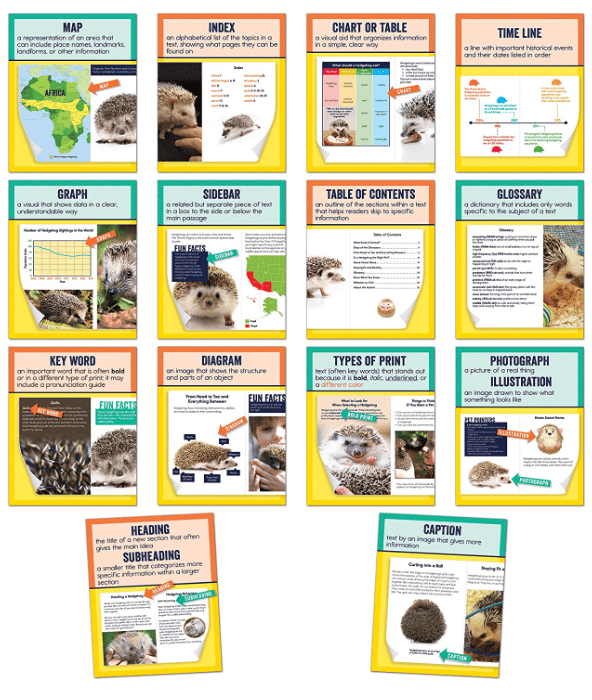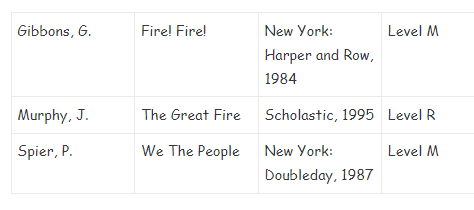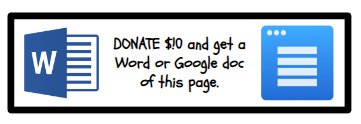

The above is a GREAT nonfiction text feature poster set sold on Amazon by Carson Dellosa – $9.99!
Here are some great nonfiction text feature videos for kids!
First, check out. . .
- Graphic Organizers to Support Reading Strategy Instruction
- Great resource!
- Another great resource! I especially like p. 4!
- Check out these great sample nonfiction text structure paragraphs for older students.
The emphasis on informational text has increased dramatically with the Common Core State Standards. According to these standards, the recommended balance of literary and informational text is as follows:
- 50% literary and 50% informational in 4th grade
- 45% literary and 55% informational in 8th grade
- 30% literary and 70% informational in 12th grade
The Common Core State Standards have raised the importance of informational texts while redefining content area literacy.
Why is content reading and writing so difficult?
It isn’t easy because it requires the following:
- knowledge of specialized vocabulary
- background knowledge
- good study/memory ability
- nonfiction reading strategies regarding various text structures (as described here)
- perseverance ~ there are multiple readability levels within a single text
- the need and ability to monitor for meaning
- judging importance while remembering many concepts
- knowledge of source reliability
- keeping one’s interest
RESEARCH SHOWS… Almost all expository texts students read can be separated into two groups: texts that describe and texts affected by time (Calfee & Patrick, 1995). Thus, elementary students encounter three descriptive and three sequential structures.
Descriptive structures focus on the attributes of something: the qualities that distinguish it from other things. For example, the writer may present the attributes of New York, glass, or rattlesnakes. The three descriptive patterns that readers encounter most frequently are list, web, and matrix (see Dymock and Nicholson [2007] for an in-depth discussion on these structures).
- List. The simplest descriptive pattern is a list. This may be a grocery list, a list of countries that grow wheat, a list of goods and services sold by street merchants in India, or science, the attributes of a kangaroo.
- Web. A web is a more complex structure than a list. This text structure is called a web because it looks like a spiderweb (Calfee & Patrick, 1995). A spiderweb has a center and several fine threads that form a network of lines. On a web, the attributes of an object are discussed. The attributes have a common link. The important thing for the student to remember is that, as a list, a web describes one thing or idea, but the difference is that a web has categories.
- Matrix. A matrix is more complex than either a list or a web. The difference between a matrix and a web or list is that a web or list describes just one thing and a matrix describes more than one thing. It compares and contrasts two or more topics. For example, it could compare types of bears, volcanoes, bicycles, or crocodiles.
Sequential structures present a series of events or steps that progress over time. Typically, sequence texts are set in a first-to-last pattern or step-by-step.
- String. A string is a detailed description of events (e.g., the sequence for baking cookies).
- Cause-Effect. Two (or more) ideas or events interact in the cause-effect text structure. One is the cause, and the other is an effect or result. For example, a text may cover the causes and effects of environmental disasters, such as an oil spill in the ocean. This pattern is typical in history, science, and health publications.
- Problem–Solution. In the problem-solution text structure, the writer states a problem or poses a question followed by a solution or answer. This text has a sequence: first, the problem, and then the solution.
The above information came from. . .
Dymock, Susan, and Tom Nicholson. “High 5!” Strategies to Enhance Comprehension of Expository Text.” The Reading Teacher 64.3 (2010): 166-78. Web.

Many people ask for the above poster, but I do not have it.
NONFICTION TEXT STRUCTURES
In the Order to be Taught:
Description, Sequence, Problem-Solution, Cause-Effect, and Compare-Contrast
- Writers use text structures to organize information. Teachers should point this out whenever students read and write.
- Skim and scan to predict text structure(s). Make predicting possible text structures a part of every pre-reading activity. Then, during reading, revise predictions about structure.
- Teach the signal words for each text structure.
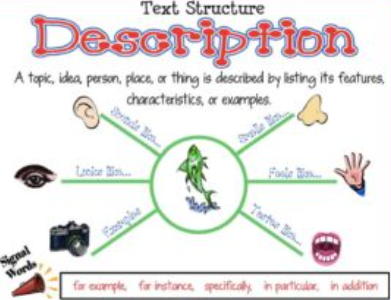
DESCRIPTION – Teach 1st

Description: Describes something by listing its features, characteristics, or examples. Signal Words:

Mentor Texts to teach Description


SEQUENCE – Teach 2nd

Sequence: Describes events in order or tells the steps to follow to make or do something. Signal Words:
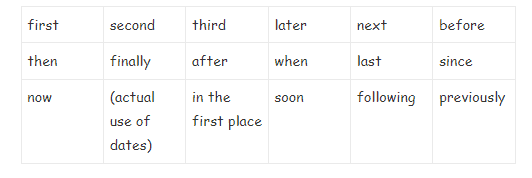
- to begin with
- most important
- also
- for instance
- in fact
- for example
- another
- not long after
Mentor Texts to teach Sequence
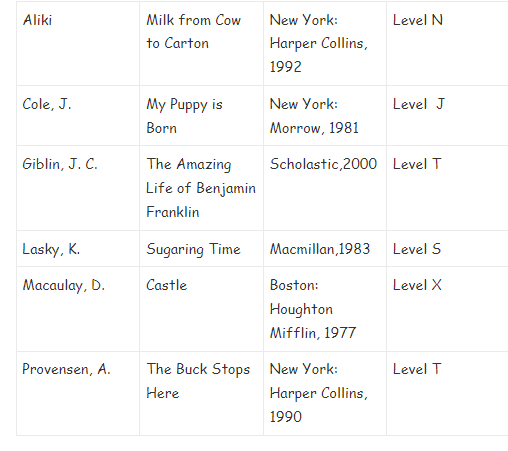
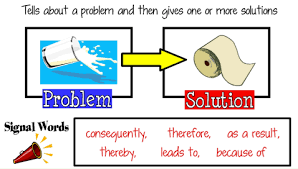
PROBLEM AND SOLUTION – Teach 3rd

Problem-Solution: Tells about or says why there is a problem, then gives one or more possible solutions to fix the problem. Signal Words:

- solution is
- difficulty is
Mentor Texts to teach Problem/Solution
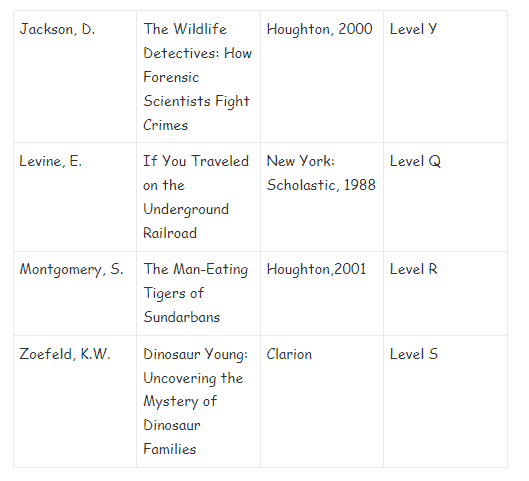

CAUSE AND EFFECT – Teach 4th
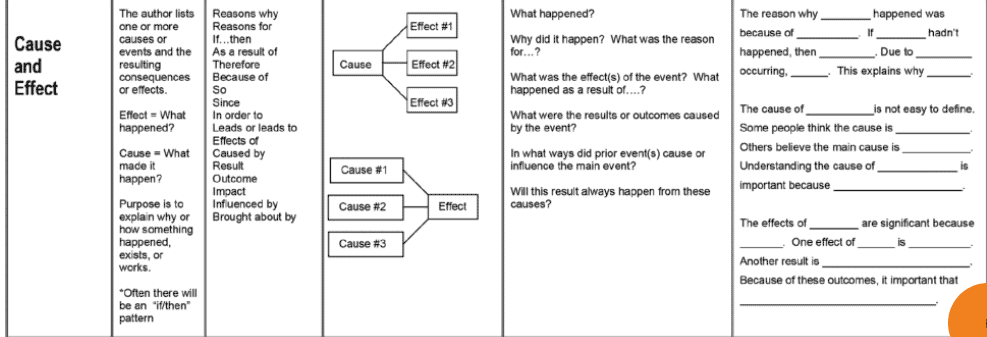
Cause-Effect: Cause is why something happened. Effect is what happened. Signal Words:

- accordingly
Mentor Texts to teach Cause/Effect
COMPARE AND CONTRAST – Teach 5th

Compare – Contrast: This shows how two or more things are alike or different. Signal Words:

not only…but also
- unless
- vs.
Mentor Texts to teach Compare/Contrast
- Teach and model the use of graphic organizers to go with each text structure. Teachers have to identify text structures in advance and provide appropriate graphic organizers.
- Teachers should model how to determine the text structure and note-taking on a corresponding graphic organizer. Then students should practice with teacher support. Finally, students should apply the skills and strategies for independent practice.
- Explicit instruction must show students how and when to use strategies such as attending to signal words while reading different content areas or using signal words when writing expository text.
- Use the think-aloud strategy. First, the teacher reads aloud a paragraph, pausing at appropriate points to share their comprehension strategies and understanding of the text. Next, move to a shared-reading strategy, encouraging students to talk aloud as they engage in the process with the teacher. For example, the teacher asks students to discuss clues to identify the text structure.
- Ask focusing questions targeting the text structure, such as which signal words are used to show a particular relationship among ideas in a text structure.
- Pictures can be drawn to model the sequence structure.
- Create and provide guides and teacher-made organizers that reflect the structure of the original text. This can help students focus on the critical elements of the reading selection.
- Present students with a completed graphic organizer as a pre-reading strategy. Have students write a probable paragraph using a predicted text structure before reading. After reading, compare students’ probable passages and the original text.
- Write using the text structures. The teacher should model writing a paragraph using a particular text structure and describe their actions as they are writing. Then students write their own paragraphs using text structure/ paragraph frames as templates.
- Make the connection between reading and writing. When students read an example of a particular text structure, have them write using that same text structure. Writing can be done as a pre-reading or post-reading strategy.
- Rewrite a paragraph or passage using a different text structure than the original. Compare the two and analyze why the author might have chosen the original pattern.
- Use summary frame questions to guide students’ comprehension before, during, and after reading. Each organizational structure suggests questions readers should consider as they read and answer once they’ve finished reading the passage.
- Use text coding strategies – highlighters, Post-It Notes, etc. – targeting text structures. Teachers must model these strategies and be consistent in the procedures (same color each time).
Identifying patterns of the organization is not the final goal ~ the final goal is for students to internalize the various text structures to improve nonfiction reading comprehension and expository writing organization.
When teaching nonfiction, think of before reading (assessing and building content knowledge), during reading (supporting and monitoring comprehension), and after reading (evaluating, extending, and transferring content knowledge) activities.
BEFORE READING
Activate Prior Knowledge – Elicit from the students what they already know.
K-W-L Chart – K (what I know), W (what I want to know), L (summarize what I learned). This activity helps activate background knowledge while building background knowledge for peers. Students can develop a list of questions about what they would like to learn from their background knowledge. Synthesizing takes place when they write what they have learned.
Skimming and Scanning – This is necessary to quickly find the most critical information in a text. Have students work in pairs to skim and scan the nonfiction text features (title, headings, glossary, maps, charts, bold-faced words, etc.), and have the students read only the first and last paragraphs. Ask what they think the text or chapter will be about. Next, have students write down questions/comments in one column and facts they quickly learned in another. What will be the critical points in the text or chapter? (Teachers may ask in what section certain information would be found. This will help assess critical thinking.)
Anticipation Guide – Anticipation Guides help activate background knowledge and build interest in an upcoming lesson. Teachers determine critical ideas in a text or chapter. Then, they write 3-8 statements that tap into the student’s background knowledge; include statements that could be opinions ~ not just facts that only can be answered by reading the text. Have students read the statements, circling agree, disagree, or yes/no. Working with a partner allows students to have discussions about expanding their knowledge. Then, students revisit the statements after reading the text. Circling agree or disagree (yes/no).
Predict-O-Gram – This is an excellent way to highlight language in a text, make predictions, and create questions before reading. The teacher reads aloud a portion of a text, then supplies the students with words that appear on the upcoming pages. The students use the words to anticipate upcoming events, suggest ways the words might be used, and ask questions they believe might be answered.
Admit Slip – Admit slips develop a purpose for reading, which, research shows, leads to a deeper understanding of a text and higher retention of information because readers create connections, storing new information in meaningful ways. The teacher copies an illustration from a textbook and lists headings and subtitles used in the text. Next, the students must write 3 questions they believe the reading will answer or list 3 pieces of information they think they will learn. Have students discuss their predictions/questions before reading and list them together. Then, read to confirm/answer the items on the list.
Teach New Words Before Reading – Whether you teach new words in context, through association, integration with background knowledge, structural analysis, compare/contrast, or visuals, understanding the new vocabulary will significantly improve students’ comprehension. Connect the new words to the reading. Not all new words need to be formally taught to understand the passages; students may figure out many new words in context. Always use integration, repetition, and meaningful use to make the new vocabulary memorable.
Advance Organizer – A graphic organizer provides students with general information about a topic before reading.
Assessing Preconceptions and Addressing Misconceptions – Brainstorm what students think they know before introducing a topic. Clarify misconceptions with hands-on activities, explanations, photographs, examples. . . before the students read; this way, they can better accept the new ideas as they read.
Ask Questions Before, During, and After Reading – Questions to Ask
DURING READING
Close Reading ~ an excellent description of this process is found on the Scholastic site, which states:
“The first time you dig your shovel in (read), you just scrape the surface off the ground. The second time you dig in (reread the text), you get a little more dirt (meaning). And every time you dig in (read) after that, your hole gets bigger and bigger until it’s just right and you get the full meaning” (quote from the UNE course). See the chart:
SQ4R ~ Survey, write Questions for each heading and subheading. Read the information in 1 section and take notes. Recite the vital information. Review questions.
Reciprocal Teaching – This strategy helps students focus and monitor their reading to achieve higher comprehension. After watching teacher demonstrations of predicting, questioning, clarifying, and summarizing from a short passage, students practice these 4 with a partner. First, assign each student a reading partner. They will read a short section together and work together through the 4 stages. For example, at the questioning stage, one student will ask questions of the other. This role is changed in the next section. Finally, they can predict, clarify and summarize together.
Classify/Categorize Information – 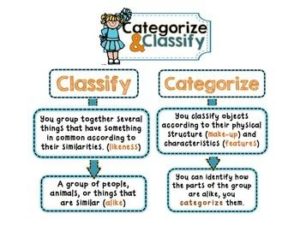
DR-TA (Directed Reading-Thinking Activity) – This strategy is helpful because of the 4 components that extend and support students’ reading and thinking: activate prior knowledge, predict, read, and revisit prediction to confirm or revise. First, the teacher asks the class to brainstorm words or ideas associated with a topic. These are recorded. Second, students examine the text’s or chapter’s features such as illustrations, graphs, charts. . . . They form predictions and questions of what they will read. Third, they have a purpose of reading. Read. Finally, students discuss the predictions that were confirmed. They discuss the predictions they revise as they read and look at their lists to see if further reading is still needed before predictions can be confirmed or changed.
TAG (Textbook Activity Guide) – A TAG is designed to support students as they read. Prompts are written for the students to help them focus on strategic processes and self-monitoring strategies to help them understand a text. The teacher reads the section on her own first, highlighting critical content. The teacher then creates a TAG to guide the students to this content as they read. In a TAG, the student works with a partner or small group. Words like “predict” and “skim” are often used in a TAG, as well as references to the nonfiction text features (glossary, bold-faced words, maps, etc.). Questions are asked, and page numbers of where the answers are are given. This can become a study guide.
Cornell Note-Taking – This strategy is effective for helping students understand and remember more of what they read or view. It supports students in making connections, developing questions, focusing and monitoring their reading, and analyzing what they have learned. The teacher will model the following first. Fold a piece of paper in half. One side is for questions, the other for notes, and leaves a space at the bottom to summarize. During reading or viewing a video clip, take notes, and develop questions that your notes would answer. Use these notes to summarize the main ideas at the bottom of the page. Have students do this individually, then compare with a partner.
Graphic Organizers – Depending on the text structure, prepare an appropriate graphic organizer for students to fill out as they read.
MORE During Reading Strategies:
Compare and Contrast Ideas
Distinguish Facts from Opinions
Identify Main Ideas and Supporting Details
Make Inferences and Draw Conclusions
Make Generalizations
Recognize Cause and Effect Relationships
Use Context Clues to Decipher Unfamiliar Words
Adjust Reading Rate/Rereading
Visualize Images From Text
AFTER READING
Summarize, Synthesize, Paraphrase/Retell
Sequence Events
Exit Slips – This strategy is suitable for assessing students’ learning at the end of class. Exit slips are short prompts for focused writing that will give the teacher feedback. For example, some exit slips may include: Write about something you learned today. What questions do you still have? How did what we learned today connect with what we knew prior?
GIST (Generating Interactions Between Schemata and Texts) – This strategy helps students write organized summaries. The teacher models this by finding a short paragraph detailing a concept, event, time period, description, problem, or sequential directions. Read the 1st sentence, and have the class summarize that sentence in 15 words or less. Read the 2nd sentence. Now have the class combine the first and second sentences into one sentence summarized in 15 words or less. Continue doing this until the paragraph is read and the whole paragraph is summarized into one sentence of 15 words or less. Have students practice on their paragraphs.
Conceptual Questions After the Passage – Have students answer questions after reading to help with recall and apply conceptual information to new situations.
Consider the Author – Identify Author’s Purpose and Viewpoint: Why Did the Author Write the Selection?
Good Readers of Informational Text
Good readers of nonfiction are ACTIVE readers! Therefore, your students should read with a pencil in hand to be engaged at all times!
- Have clear goals for their reading
- Preview the text before reading, noticing the nonfiction text features
- Activate prior knowledge
- Make predictions
- Use meaning, and expect the text to make sense
- Monitor their reading ~ and ask, “Do I understand this?”
- Make connections: text to self, text to text, text to world
- Create visual images
- Use the text features (heading, captions, maps, etc.) actively and consciously.
- Draw inferences and conclusions
- Ask questions as they read
- Read different kinds of informational texts differently
- Skim and scan to recheck the information
- Locate information
- Adjust reading rate to match text demands
- Make a plan when reading ~ take notes in margins, use a color-coded post-it-note system of interesting information, confusing parts, questions. . .
- Identify essential ideas and words.
- Shift strategies to match the purpose
- Retell, summarize, synthesize
- Use fix-up strategies: read on and go back, backtrack, context clues, make substitutions, and break unfamiliar words into parts.
Nonfiction Writing/Speaking Prompts
- I learned. . .
- I never knew. . .
- I already knew that. . .
- I was wrong to think. . .
- I wonder why. . .
- I still don’t know. . .
- An important date is. . .
- The confusing thing is. . .
- ____ (nonfiction text feature) helped me explain. . .
- I was surprised. . .
- I also want to read. . .
- The index helped me. . .
- I like learning. . .
- I would recommend this book to. . .
- I would like to share my learning by. . .
- Some interesting facts are. . .
- I want to learn more about. . .
- This book answered my questions about. . .
Copyright 06/02/2012
Edited on 03/06/2024
References
Allen, Janet. Tools For Teaching. Stenhouse Publishers, 2004.
Hoyt, Linda. Make It Real. Portsmouth, NH: Heinemann, 2002.
www.essdack.org ~ Reading and Writing Consultant, Kristi Orcutt
Copyscape alerts me to duplicate content. Please respect my work.

![]()

